Abstract
Coal plays an extremely important role in the global primary energy consumption structure; It is of great significance to analyze the types of coal mine accidents in major coal producing countries. This paper makes a comparative analysis of the types of coal mine accidents in the USA, Australia, Russia, India, and China, which has a significance for further improving coal mine safety in various countries.
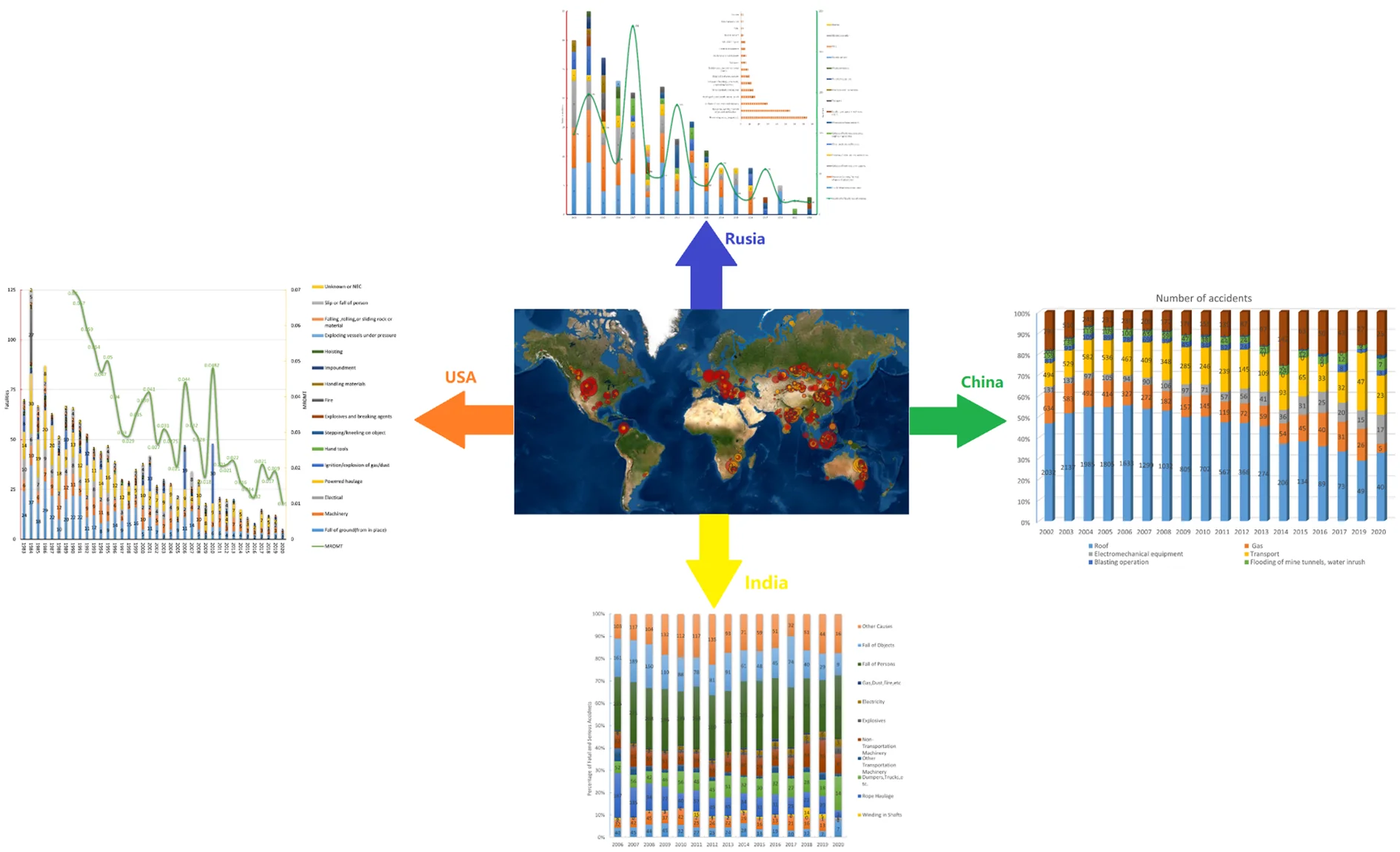
Highlights
- This paper collects the basic information of the number of coal mines, the number of coal miners, age, wages and coal mine accidents in the world's major coal producing countries for the first time.
- This paper makes a comparative analysis of the types of coal mine accidents in the USA, Australia, Russia, India, and China.
- The analysis of the types of coal mine accidents in the world's major coal producing countries, which has a significance for further improving coal mine safety in various countries.
1. Introduction
The Global Coal Mine Tracker (GCMT) provides information about the major coal mines in the world (every operating mine producing 3 million tons per year or greater, and every proposed mine with a capacity of 1 million tons per year or greater), the GCMT tracks 1513 coal mines (1085 operating coal mines and 485 proposed coal mines) in 59 countries around the world. These coal mines are mainly distributed in China, India, the USA, Australia, Russia, Indonesia and other countries, as shown in Fig. 1 and Table 1. In 2020, the total global coal output was 7112 Mt (Million tons), and the coal output of the top six major coal producing countries accounted for 90.16 % of the world, such as Chinese 3743 Mt (52.6 %), Indian 779 Mt (10.95 %), Indonesian 551 Mt (7.7 %), the USA’s 488 Mt (6.86 %), Australian 473 Mt (6.65 %) and Russian 386 Mt (5.4 %). China had the largest number of coal mines, about 5251 coal mines in 2020 (4700 coal mines in 2021).
Fig. 1Capacity view of operating mines over 5 Mt and Proposed over 1 Mt from Global Coal Mine Tracker (2021)
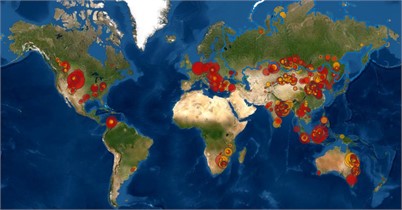
In terms of coal mine safety, for the statistics of deaths and Fatality Rate Per Million Tons (FRPMT) in coal mines of China, the USA, Russia, Australia, and India from 1991 to 2020 (open-pit and underground coal mines, i.e., OPCM and UCM), the data of five countries were obviously divided into three groups, as shown in Fig. 2 and Fig. 3. The first group includes Australia [1-4] and the USA [5-9], especially since 2000, the number of deaths in coal mine of the USA is less than 50 deaths per year (i.e. DPY) and Australia is less than 10 DPY, the FRPMT of the two countries is lower than 0.05 (Australia is lower than the USA). The second group includes India [10-13] and Russia, the DPY is lower than 100, the FRPMT has been at 0.1 in recent years, and the FRPMT has decreased slowly; the third group includes China [14-16], coal mine safety has improved significantly in the past three decades, and the DPY and the FRPMT have decreased significantly, from 6269 deaths and 5.78 (FRPMT) in 1991 to 225 deaths and 0.058 in 2020. Chinese FRPMT has been the same as that of India and Russia in recent years, but it is still higher than Australia and the USA.
The condition of coal mining in China is complex and different from other countries, UCM accounts for a substantial proportion [17], and the coal reserve buried deeply with serious disasters such as gas, roof, water, and heat. Chinese UCM accounts for 93.5 % of the total number of coal mines, and only 6.5 % of OPCM in 2020. The output of OPCM abroad accounts for a high proportion, such as 83.7 % in Australia, 75.7 % in Russia, 62.2 % in the USA and 94.1 % in India. Globally, the safety situation of coal mine in China has improved, and there may be room for further improvement.
This paper is studying and comparing the accident types of coal mine in China, the USA, Russia, India, and Australia, and providing some useful information in order to improving the safety situation of coal mining.
Fig. 2Coal mine deaths and MROMT in China, the USA, Russia, India, and Australia (1991-2020)
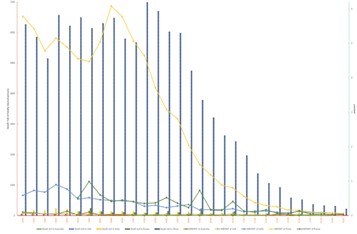
a)
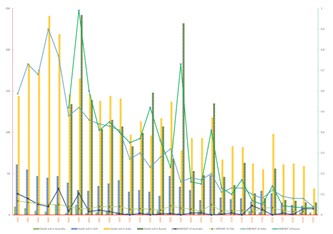
b)
2. Coal mine accidents in coal producing countries
2.1. The USA
Due to the influence of COVID-19 in 2020, the number of producing coal mines in the U.S. fell to 561 (1134 coal mines in 2019), of which 370 were active, 151 were idle or closed, 40 were new or reactivated, and 63649 coal miners (fell to 41000 coal miners in 2021), accounting for 0.049 % of the U.S. civilian labor force (130 million). Among the coal miners, 60 % work in UCM and 40 % work in OPCM. Most coal miners (90 % male and 10 % female) are men without a university degree, with an average annual salary of $63280. The main coal producing areas are Appalachia (26 %), interior (17 %) and Western (57 %). There are 449 coal mines in Appalachia (285 OPCM, 164 UCM, 80 % of the coal in Appalachia come from UCM), 45 coal mines in the western region (mainly OPCM, half of the coal output of the United States comes from the western region), and 57 coal mines in the central region.
The coal mine accidents statistics of the United States from 1983 to 2020 have showed that 2885 miners died, including 1484 coal miners (929 died in UCM, accounting for 62.6 %; 555 died in OPCM, accounting for 37.4 %). accounting for 51.44 %. Appalachia has the largest number of coal miners in the United States, with more than 30254 miners. The number of coal mine deaths was quite concentrated in Appalachia, as shown in Fig. 3.
There are 16 types of coal mine accidents in the United States, as shown in Fig. 4(a), mechanical injury (15.28 %), power transportation (25.63 %) and in-situ fall (27.59 %) the three main causes of accidents accounting for 68.5 % of the total number of deaths, which are different from the main causes of coal mine accidents in China (mainly roof and gas accidents). Unlike China, ignition or gas/coal dust explosion ranks only the fourth among the causes of coal mine accidents in the USA, accounting for 8.18 %.
At the same time, there are 6 types of accident causes for more than 50 coal miners, such as fall or slip (57), electrical (107), ignition or gas/coal dust explosion (121), machinery (226), power transportation (379) and in-situ fall (408), as shown in Fig. 4(b), and these six types of accidents need special prevention.
Fig. 3Geographical distribution of fatalities in open pit and UCM in the USA (1983-2020)
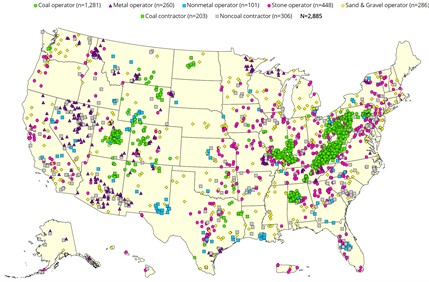
Fig. 4Number of deaths in different accident causes and FRPMT of coal mine in the U.S. (1983-2020)
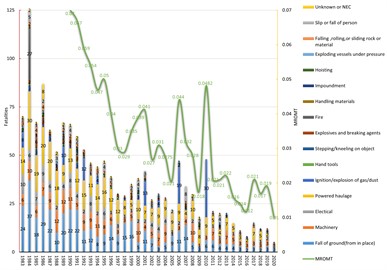
a)
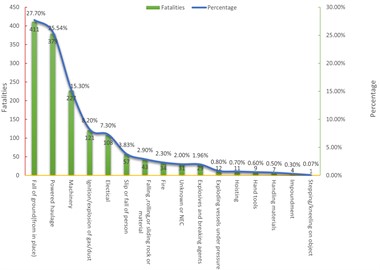
b)
2.2. Australia
Coal is the most important energy in Australia, and 60 % of electricity comes from coal. Australian coal (black and lignite coal) accounts for 14 % of the global coal reserves, ranking behind the USA (24 %) and Russia (15 %). The main coal producing states are Queensland and New South Wales (also the main places of coal mine accidents), the mining method is mainly open-pit mining. 104 deaths (3.47 DPY) in coal mine from 1991 to 2020, including 60 deaths (57.7 %) in UCM and 39 deaths (37.5 %) in OPCM, the deaths in UCM is 1.54 times that in OPCM, as shown in Fig. 5. There were 91 coal mines in Australia in 2020, and 38918 coal miners [18-19], but only 3 coal miners died in coal mine accidents, and the FRPMT was 0.03, was mainly injury accidents. Take new South Wales as an example, coal enterprises in New South Wales reported 1667 coal mine incidents to government regulators in 2020, including 70 serious injuries (64 % occurred in UCM) and 0 deaths. Since 2010, the number of coal mine accidents notified by the coal sector to government regulators has decreased by 40 %, and two-thirds are in UCM.
Fig. 5Number of deaths and MROMT in coal mine accidents in Australia (1991-2020)
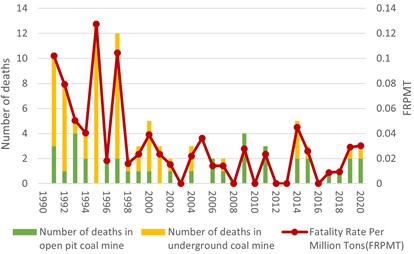
2.3. India
As to the latest data of the Geological Survey of India, there is 319 billion tons of coal reserves (2021) in India, it is the second largest producer and importer of thermal coal in the world. Coal accounts for 55 % of Indian total energy demand, and more than 70 % of electricity comes from coal. Which coal resources are distributed in 27 coal fields (Most in Eastern and central and southern regions), mainly in (upper and lower) Gondwana coal fields (accounting for 98 % of Indian total coal reserves and 99 % of the total output) and Tertiary coal fields. Most of the coal seams are shallow and thick, 94.1 % of the total output of coal is from OPCM, which is the first reason for the low number of deaths in coal mine accidents in India; The second reason is that, India has a high concentration of coal production capacity, there are 590 legal coal mine enterprises[20], and the output of state-owned coal mines accounts for more than 90 % (for example, Coal India Ltd, the third largest Indian state-owned coal company in the world, has 272445 employees and 352 coal mines in 82 mining areas, 2.5 Mt per day, the CIL company controls 85 % of Indian coal production, accounting for 7.8 % of the global share, second only to Chinese Shenhua Energy Co., Ltd and BHP Billiton Co., Ltd), and private coal mines account for less than 7 %. The third reason is that there are thousands of illegal coal mines in India, and it is difficult to count the accident data. Such as Dhanbad, the “Capital of Coal” in India, there were 112 legal coal mines (27.5 Mt per year) and more than 1000 illegal coal mines (17-20 Mt per year) in 2019. The fourth reason is that many coal miners in the country are not in the national regulatory system. Indian statistics shows that, there are about 5.6 million coal miners in India (daily employment) [20], about 470000 coal miners (270000 formal coal miners and 200000 contract coal miners) officially join the five coal unions in India (INTUC, HMS, CITU, AICWF and AITUC), but 5.13 million coal miners are not in the regulatory system of the Indian government and coal union organizations, so the number of casualties in coal mine accidents is difficult to count and reported.
Fig. 6Cause-wise distribution of Fatal accidents in coal mines in India (2006-2020)
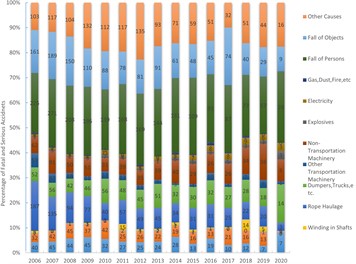
a)
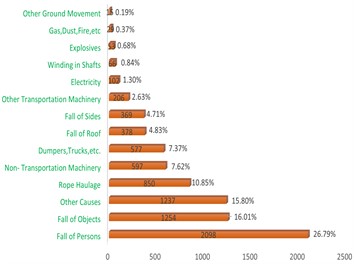
b)
12233 coal mine accidents have occurred from 2006 to 2020 in India, with 1744 coal miners and 11276 injuries of the Annual Report of the Ministry of Labor and Employment of India [22-32], the FRPMT has decreased from 0.4 to 0.04 with a decrease of 90 %. The inducements of coal mine accidents are scattered, which are less than 30 %. There are 4 types of the accident causes more than 10 %, such as fall of persons (26.79 %), fall of objects (16.01 %), other causes (15.80 %) and steel wire rope transportation (10.85 %). And the ground movement of roof and floor, such as fall of roof and fall of sides, accounts for 9.54 %. Gas and coal dust, Fire (gas, dust, fire, etc.) accounts for only 0.37 %, as shown in Fig. 6.
2.4. Russia
According to the Annual Report of the Environment, Technology and Atomic Energy Supervision Bureau of the Russian Federation, the Russian Regulatory Authorities inspected 6564 dangerous production facilities in the coal industry, covering 90 coal mines, 302 coal mining faces and 86 coal preparation facilities in 2020. The average number of employees in the Russian coal industry was 166450.
The statistics of the Environment, Technology and Atomic Energy Supervision Bureau of the Russian Federation from 2003 to 2020 [33-37] was shown in Fig. 9, 255 coal mine accidents have occurred, killing 1103 coal miners, and there were 16 types of coal mine accidents, including Fire (endogenous, exogenous), Explosion (burning, flashes) of gas and carbon dust, Collapse of rock mass and supports, Flooding of mine tunnels, water inrush, Collapse of buildings, structures, engineering facilities, Mountain collapse, support, Sudden coal, gas and rock burst (rush), Transport, Machines and mechanisms, Electrical equipment, Mountain impact, Electric current, Falls, Blasting operation, and Bounce, and Other accidents and injuries(analysis of 9 accidents in 2009 was losing). Among them, the top two are Fire (endogenic and exogenic,74 accidents, accounting for 30 %), and Explosion (burning, flashes) of gas and carbon dust (55 accidents, accounting for 22.4 %), as shown in Fig. 7.
Fig. 7Accident types of coal mine and deaths in Russia (2003-2020)
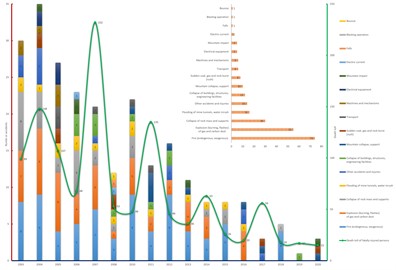
2.5. China
China is the largest coal producer and consumer in the world, there were 5251 coal mines in 24 coal producing provinces(autonomous regions and municipalities directly under the central government) in 2020 (about 4700 coal mines in 2021), including 2661 operating coal mines, 589 proposed coal mines and 2001 stopped production and construction coal mines, of which 40 % of the coal mines have various disaster factors (gas, flood, geology, etc.), and the number of coal miners was about 4 million. 123 coal mine accidents occurred with 228 coal miners died in 2020, and the FRPMT of China was 0.058, which was the same as those developed countries.
Chinese coal mine accidents mainly include Roof, Gas, Electromechanical, Transportation, Blasting, Water, Fire and Other accidents. According to the statistics of the National Mine Safety Administration, as shown in Fig. 8, there were 30025 coal mine accidents and 49615 deaths from 2002 to 2020. The top two accuses of coal mine accidents and deaths were Roof (15228 coal mine accidents, accounting for 50.72 %; 17922 deaths, accounting for 36.12 %) and Gas accidents (3657coal mine accidents, accounting for 12.18 %; 15043 deaths, accounting for 30.32 %).
For the severity of coal mine accidents in a single accident, the average number of deaths in Fire Accidents is 7.94 / case, which is mainly serious accidents. The average number of deaths in Gas Accidents is 4.11 persons/case, that is mainly serious accidents. The average number of deaths in Roof Accident is 1.18 persons / case, so it is mainly general accidents, as shown in Fig. 9.
As shown in Table 1, it is summarized the basic information of the global major coal producing countries. As a sunset industry, the disadvantages of coal mining are more prominent, compared with the high-tech industry, the technology of the coal industry is far from advanced. At the same time, the age of coal miners is too old (43.3-44 years old in the United States and 40-50 years old in China, India is better, considering the huge structure of young people in India), and the educational background is generally below bachelor's degree. In terms of mining wages, there is still a big gap between developed and developing countries, but on the optimistic side, globally, with the progress of science and technology, there is still a lot of room for further improvement of safety production in the coal mining industry.
Fig. 8Number of different types of coal mine accidents and deaths in China (2002-2020)
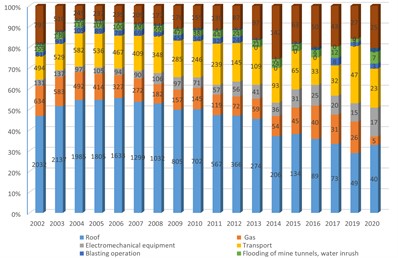
a) Number of accidents
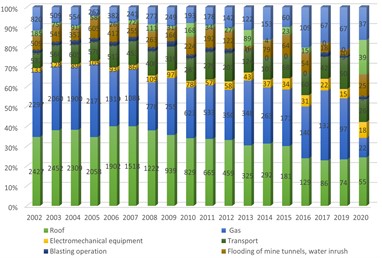
b) Death toll
Fig. 9Deaths of different types of coal mine accidents / case (2002-2020)
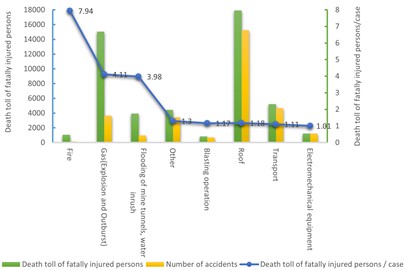
Table 1Basic information of the global major coal producing countries
Country | Total | Underground coal mine | Open pit coal mine | Number of coal miners | Average yearly earnings ($) |
China | 5,300 | 93.50 % | 6.50 % | 4,000,000 | 15,000 |
India | 590 | 5.90 % | 94.10 % | 5,600,000 | 8,000 |
USA | 561 | 37.40 % | 62.60 % | 63,649 | 63,280 |
Australia | 91 | 16.30 % | 83.70 % | 38,918 | 100,000 |
Russia | 90 | 24.30 % | 75.70 % | 166,450 | 12,000 |
3. Conclusions
The following conclusions can be drawn based on the research and comparison:
1) Globally, compared with OPCM, UCM are more prone to coal mine accidents.
2) In terms of accident types, China is prone to gas and roof accidents; The United States is prone to falling, traction and mechanical accidents; India is prone to falling (people and objects) and other accidents; Russia is prone to fire and explosion accidents.
3) The number of coal mine accidents and deaths in the world’s major coal producing countries are further declining. With the progress of science and technology and the promotion of unmanned working face, coal mine accident 0 deaths will appear soon.
References
-
Lan Xiaomei and Li Yanqiang, “Development trend of Australian coal industry,” China Coal, Vol. 47, No. 2, pp. 89–101, 2021, https://doi.org/10.19880/j.cnki.ccm.2021.02.015
-
Dai Haijun and Ma Chao, “Austrilia’s mine occupational safety and health supervision system and its enlightenment,” China Coal, Vol. 45, No. 11, pp. 122–127, 2019, https://doi.org/10.19880/j.cnki.ccm.2019.11.021
-
“Queensland mines and quarries safety performance and health reports – DNRME.” Queensland Government, 2021, https://www.publications.qld.gov.au/dataset/queensland-mines-and-quarries-safety-performance-and-health-reports
-
“Mine safety performance report 2019-2020.” NSW Resources Regulator, 2021, https://www.resources regulator.nsw.gov.au/news/2021/mine-safety-performance-report-2019-2020.
-
Huang Wenjie, “Development tendency of the USA coal industry,” China Coal, Vol. 47, No. 1, pp. 136–143, 2021, https://doi.org/10.19880/j.cnki.ccm.2021.01.020
-
Wu Daming, “Research on graded and classified supervision in the United States and references on disaster prevention measures of coal mines in China,” China Coal, Vol. 43, No. 12, pp. 165–169, 2017, https://doi.org/10.19880/j.cnki.ccm.2017.12.032
-
He Jinxiang and Guo Juan, “Present Situation and Development Prospect of American Coal Industry,” Land and Resources Information, 2021.
-
Sun Chao, Huang Wenjie, and Gui Tianzhu, “The development trend of American coal industry and its enlightenment to China,” Coal Economic Research, Vol. 41, No. 2, pp. 51–58, 2021, https://doi.org/10.13202/j.cnki.cer.2021.02.009
-
Liu Yi and Fan Shao, “Analysis on development history and experience of coal mine safety in developed countries,” China Coal, Vol. 44, No. 10, pp. 174–181, 2018, https://doi.org/10.19880/j.cnki.ccm.2018.10.032
-
Yin Wentao, “Analysis of India coal mine safety and enlightenment to China,” China Coal, Vol. 47, No. 4, pp. 89–93, 2021, https://doi.org/10.19880/j.cnki.ccm.2021.04.013
-
“Annual Report.” Directorate General of Mines Safety Ministry of Labor and Employment Government of India, 2021, https://labour.gov.in/annual-reports
-
“Statistics of Mines in India Volume-1.” Directorate General of Mines Safety Ministry of Labor and Employment Government of India, 2015, http://dgms.gov.in/writereaddata/uploadfile/coal_2015.pdf.
-
A. Mandal and D. Sengupta, “The Analysis of Fatal Accidents in Indian Coal Mines,” Calcutta Statistical Association Bulletin, Vol. 50, No. 1-2, pp. 95–120, Mar. 2000, https://doi.org/10.1177/0008068320000109
-
Li Dasheng, “Comparative research into the situation of coal mine safety at home and abroad,” China Mining Magazine, Vol. 24, No. 8, pp. 45–48, 2015.
-
Huang Ji-Guang, Ma Han-Peng, Fan Chun-Jiao, and Yao Rong-Rong, “Statistical analysis and pridiction of coal mine safety accidents in China,” Shaanxi Coal, Vol. 39, No. 3, pp. 34–39, 2020.
-
Ding Baichuan. “Characteristics and cause analysis of coal mine accidents in China in 2020.” China Energy News. http://www.coalchina.org.cn/index.php?m=content&c=index&a=show&catid=40&id=126226
-
He Youguo, Liu Wenge, and Li Yanqiang, “Overview of world coal industry development,” China Coal, Vol. 47, No. 1, pp. 126–135, 2021, https://doi.org/10.19880/j.cnki.ccm.2021.01.019
-
“Australian Energy Update 2020.” Australian Government Department of Industry, Science, Energy and Resources, 2020, https://www.statista.com/statistics/692159/australia-employment-in-coal-mining-industry/
-
“Queensland mines and quarries safety performance and health report (2019-2020).” Queensland Government, 2021, https://www.publications.qld.gov.au/dataset/queensland-mines-and-quarries-safety-performance-and-health-reports/resource/2ff4e6cd-d822-41c8-b875-7ef9c23fe8a2
-
“Risk assessment as a tool of mines safety in India.” The Indian Institute of Public Administration, 2020, https://www.iipa.org.in/cms/public/uploads/313601615975748.pdf
-
“Annual Report 2020-21.” Ministry of Labour and Employment Government of India, New Delhi, 2021, https://labour.gov.in/annual-reports
-
“Annual Report 2019-20.” Ministry of Labour and Employment Government of India, New Delhi, 2020, https://labour.gov.in/annual-reports
-
“Annual Report 2018-19.” Ministry of Labour and Employment Government of India, New Delhi, 2019, https://labour.gov.in/annual-reports
-
“Annual Report 2017-18.” Ministry of Labour and Employment Government of India, New Delhi, 2018, https://labour.gov.in/annual-reports
-
“Annual Report 2016-17.” Ministry of Labour and Employment Government of India, New Delhi, 2017, https://labour.gov.in/annual-reports
-
“Annual Report 2015-16.” Ministry of Labour and Employment Government of India, New Delhi, 2016, https://labour.gov.in/annual-reports
-
“Annual Report 2014-15.” Ministry of Labour and Employment Government of India, New Delhi, 2015, https://labour.gov.in/annual-reports
-
“Annual Report 2013-14.” Ministry of Labour and Employment Government of India, New Delhi, 2014, https://labour.gov.in/annual-reports
-
“Annual Report 2012-13.” Ministry of Labour and Employment Government of India, New Delhi, 2013, https://labour.gov.in/annual-reports
-
“Annual Report 2011-12.” Ministry of Labour and Employment Government of India, New Delhi, 2012, https://labour.gov.in/annual-reports
-
“Annual Report 2010-11.” Ministry of Labour and Employment Government of India, New Delhi, 2011, https://labour.gov.in/annual-reports
-
“Annual Report 2009-10.” Ministry of Labour and Employment Government of India, New Delhi, 2010, https://labour.gov.in/annual-reports
-
“Report on the activities of the federal agency for environment, technology and atomic supervision in 2004,” (in Russian), Federal environmental, technical and atomic energy supervision agency, Moscow, 2005.
-
“Report on the activities of the federal agency for environment, technology and atomic supervision in 2005,” (in Russian), Federal environmental, technical and atomic energy supervision agency, Moscow, 2006.
-
“The 2006 Report of the Federal Environmental, Industrial and Nuclear Supervision Service of Russia,” (in Russian), Federal Environmental, Industrial and Nuclear Supervision Service of Russia, Moscow, 2007.
-
“Annual Report on Activities of the Federal Environmental, Industrial and Nuclear Supervision Service in 2012,” Federal Environmental, Industrial and Nuclear Supervision Service, Moscow, 2013.
-
“Report on the activities of the federal agency for environment, technology and atomic supervision in 2020,” (in Russian), Federal environmental, technical and atomic energy supervision agency, Moscow, 2021.
-
Lyu Qian, Fu Gui, Jiang Lihui, and Yang Chun, “Comparative Analysis of Unsafe Acts of Gas Explosion Accidents in China and American,” Safety in Coal Mine, Vol. 50, No. 9, pp. 240–243, 2019, https://doi.org/10.13347/j.cnki.mkaq.2019.09.057
